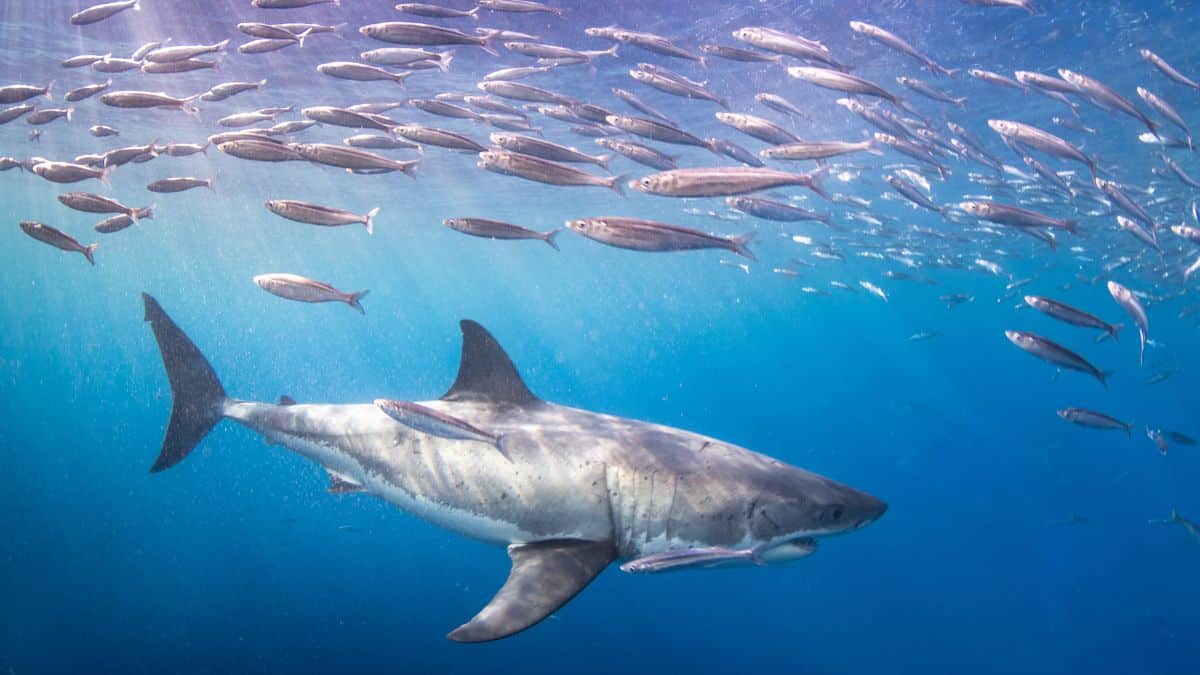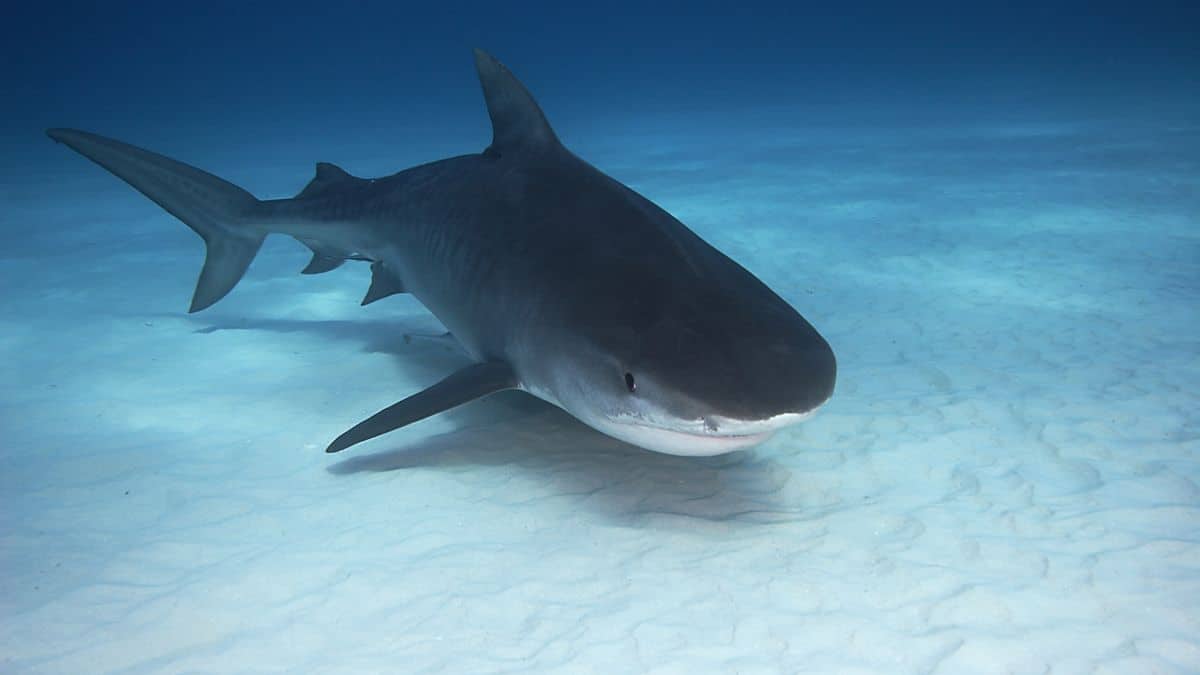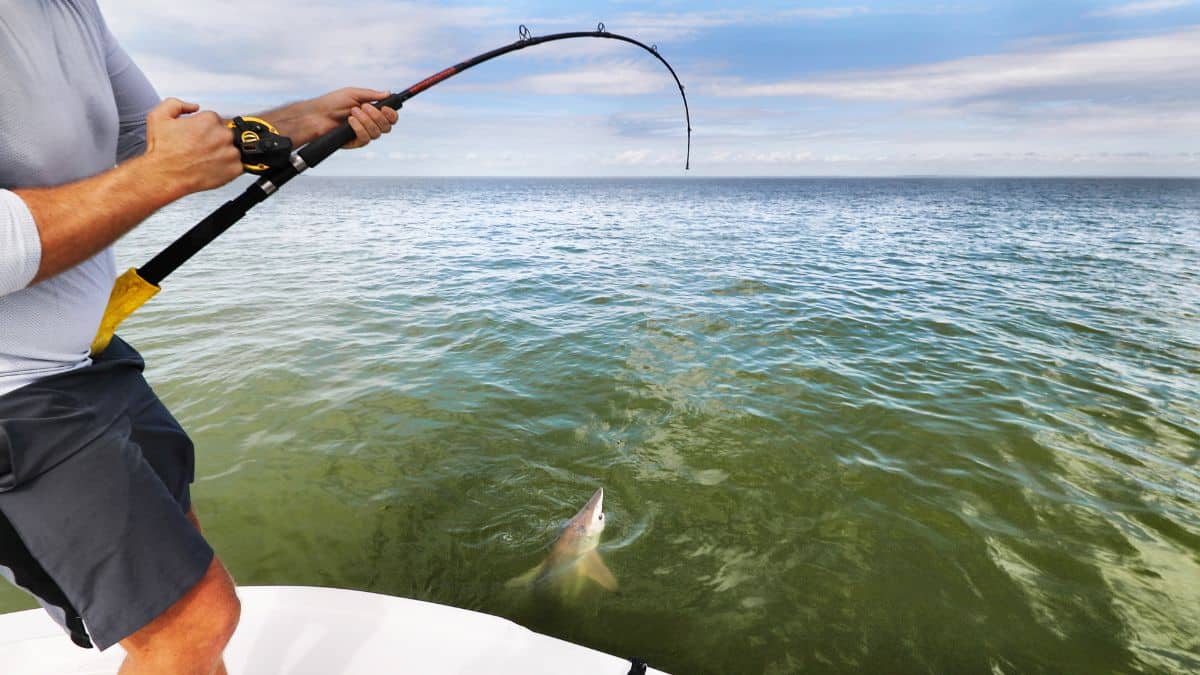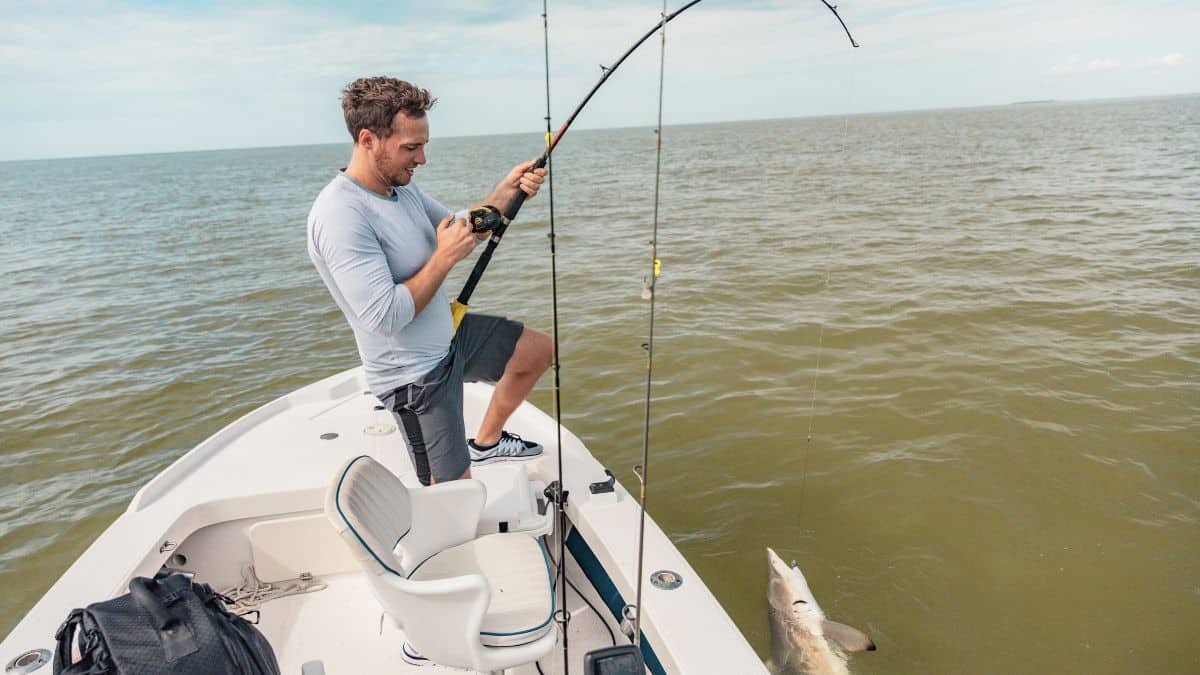Shark fishing is a thrilling and challenging activity that attracts many anglers searching for the ultimate catch. One crucial aspect of successful shark fishing is bait selection.
Using the best bait is essential to increase the chances of catching big sharks. Circle hooks are often considered the best way to catch larger shark species due to their effectiveness and ease of use.
Water temperatures play a significant role in determining which shark species are present in a given area. For instance, warm water is ideal for spinner sharks, black tips, and bull sharks, while deeper water may attract larger species, such as mako sharks and tiger sharks.
Fresh bait, including small fish and live bait, is essential to attract both small and large sharks. Fresh and oily fish, such as Spanish mackerel or blue runners, can also be great bait options.
In general, larger baits work best for larger sharks, while smaller bait is suitable for smaller sharks. A steel leader and good fishing line help ensure a successful catch, especially when dealing with the sharp teeth of these apex predators.
The right bait and appropriate equipment, combined with knowledge of the preferred habitat and habits of different shark species, will significantly enhance the shark fishing experience for both novice and experienced anglers.
Best Bait for Shark Fishing

When it comes to shark fishing, using the best bait is crucial for success. Various types of bait work well with different shark species, water temperatures, and fishing conditions.
In this section, we’ll discuss some popular bait options for shark fishing, including mackerel, bluefish, mullet, bunker, barracuda, jack crevalle, amberjack, squid, bonito, herring, kingfish, and stingray.
Mackerel
Mackerel, particularly Spanish mackerel, is a top choice among shark anglers. This oily fish is abundant in warmer waters during summer, creating an enticing scent trail for sharks.
Mackerel can be used as both live bait and cut bait, making it versatile and effective for various shark species.
Bluefish
Bluefish is another popular choice for shark fishing, especially for large spinning reels. Its oily flesh produces a strong scent attracting big sharks like bull and great white sharks.
Fresh bluefish can be used as cut or live bait, although they’re typically more challenging to keep alive in captivity.
Mullet
Mullet is an excellent bait for sharks due to its high oil content and natural abundance in shallow waters. Live mullet is particularly effective for catching sharks like blacktip and sandbar sharks. When surf fishing, live mullet can be used with circle hooks to target these smaller sharks.
Bunker
Also known as menhaden, bunker is a good choice for shark bait due to its oily nature and common presence in various shark habitats.
It can be used whole, live or cut into smaller pieces. Bunker is readily available and inexpensive, with fresh bait offering the best results.
Barracuda
Barracuda is a popular bait for catching larger sharks, particularly tiger sharks. This muscular fish has a strong scent that can attract big fish from long distances.
When using barracuda for bait, using a wire leader is important, as their sharp teeth can easily cut through the main line.
Jack Crevalle
Jack crevalle is a widely available baitfish that is particularly effective for catching small to mid-sized sharks.
When using jack crevalle as bait, opt for live or freshly cut pieces to increase the chances of attracting sharks.
Amberjack
Amberjack is a good choice for deep water shark fishing due to its preferred habitat and strong scent.
This bait is particularly effective for catching larger sharks like mako sharks and great white sharks.
Squid
Squid is a popular bait choice for a variety of shark species, as it has a strong scent and is readily available.
Both fresh and frozen squid work well, with larger pieces being best suited for larger sharks, while smaller pieces can be used for smaller sharks. Be sure to use a circle hook to prevent the shark’s mouth damage.
Bonito
Bonito is a oily fish that is versatile and effective for shark fishing. It can be used live, cut, or even as chum to attract sharks. Bonito works well with sharks, from smaller black tips to larger predators like mako and great white sharks.
Herring
Herring is a popular and accessible bait option, and its high oil content creates an enticing scent trail for sharks.
Fresh herring is most effective, whether used whole, live, or cut into pieces, targeting various shark species.
Kingfish
Kingfish, also known as king mackerel, is a potent bait for shark fishing due to its large size and distinctive scent. Kingfish can be effective in attracting larger sharks like bulls and tiger sharks.
Stingray
When targeting large sharks such as hammerheads, stingrays are the bait of choice. Be sure to handle stingray with care, as their barbs can inflict painful injuries.
Using stingray as bait typically involves cutting the wings into large chunks, ensuring the bait remains in place on the circle hooks.
Fishing Guide: Best Bait for Deep Sea Fishing
Selecting the Best Bait for Different Shark Species

When it comes to shark fishing, selecting the right bait is crucial for success. Different shark species have different preferences, and using the best bait for each species will greatly improve your chances of catching them.
This section will cover the best bait choices for several shark species, including Tiger Sharks, Hammerhead Sharks, Mako Sharks, Bull Sharks, Blacktip Sharks, Sandbar Sharks, and Dusky Sharks.
Tiger Shark
Tiger Sharks are some of the ocean’s most opportunistic feeders and are known to eat a wide variety of prey. For tiger shark fishing, larger bait is generally a good choice.
Fresh fish like Spanish mackerel, blue runners, and mullet are all reliable options. Large baits will attract the attention of the large apex predators and are a great way to entice them to bite.
Hammerhead Shark
Hammerhead Sharks are typically found in warmer waters and are often attracted to the scent of oily fish.
This makes fresh fish like Spanish mackerel, blue runners, and mullet particularly effective bait options for Hammerhead Sharks. Live bait is preferred, but cut bait can also work well.
Mako Shark
Mako Sharks are fast, aggressive predators and prefer smaller, faster prey like small fish and squid. The best bait for Mako Sharks are live or freshly caught smaller fish like mackerel, herring, or sardines.
These smaller baits are more likely to pique the interest of Mako Sharks, as they mimic the high-energy prey they prefer.
Bull Shark
Bull Sharks are known for their preference for freshwater and brackish environments. They are typically found in shallow waters, making them a popular target for surf fishing.
The best bait for catching bull sharks includes fresh fish like Spanish mackerel, mullet, and menhaden. Using a circle hook with a wire leader can greatly improve your chances of successfully landing bull sharks.
Blacktip Shark
Blacktip Sharks are smaller than other species, but don’t let that fool you – they are still aggressive predators.
The best bait for blacktip sharks includes live bait like mullet, menhaden, and blue runners. Smaller live bait is also effective, as blacktip sharks tend to focus on smaller fish as prey.
Sandbar Shark
Sandbar Sharks prefer to hunt in deeper waters, where they can easily find prey like small fish and squid. The best bait for Sandbar Sharks is often live or freshly caught smaller fish like mackerel, herring, or sardines.
It is also worth noting that Sandbar Sharks are more likely to be caught during summer months when water temperatures are warmer.
Dusky Shark
Dusky Sharks can be found near deep water drop-offs and often hunt during twilight hours. The best bait for Dusky Sharks includes live or freshly caught smaller fish like mackerel, herring, or sardines.
Select a bait that matches the location and depth where you expect to find these larger sharks.
Shark Fishing Equipment

Rod and Reel
When it comes to shark fishing, choosing the right equipment is essential for success. For targeting small to medium-sized sharks, a 7 to 9-foot heavy-action rod paired with a large spinning reel capable of holding at least 400 yards of line is recommended.
Consider using a 10 to 12-foot rod and a heavy-duty conventional reel for larger sharks.
Line and Leader
The main fishing line should be around 50 to 80 lb braid, depending on the size of the shark you’re targeting. An essential aspect of shark fishing is using a strong leader made of heavy wire or monofilament.
A wire leader is typically around 9 to 12 feet long and is needed as protection against the sharp teeth of sharks.
Line Type Recommended Size:
- Braid 50 to 80 lb
- Wire Leader 9 to 12 ft
Circle Hooks
Circle hooks are handy for shark fishing as they benefit both anglers and sharks.
The design of circle hooks makes it easier to securely hook the shark and reduce the chances of gut-hooking or injuring the shark, increasing their chances of survival upon release. Opt for circle hooks in sizes 6/0 to 20/0, depending on the shark species you plan to catch.
Shark Rig
A shark rig typically consists of a wire leader connected to a circle hook, with the other end of the wire leader connected to a heavy-duty swivel.
The swivel is then connected to a shorter monofilament or fluorocarbon leader, which is finally tied to the main fishing line. This setup prevents your line from getting tangled during a fight with a large shark.
Weights and Sinkers
Weights and sinkers are essential to keeping the best bait in the right position in the water column. For surf fishing, pyramid sinkers are preferred, while for deep water or open ocean fishing, a sliding weight on your main line might be the best bet.
When fishing for smaller sharks in shallow waters, a minimal amount of weight is needed, whereas bigger bait and larger sharks in deeper water will require heavier weights.
Techniques for Shark Fishing
Chumming
Chumming is a great way to attract sharks to your fishing spot. Start by using fresh bait or oily fish to create a scent trail.
This will draw in small and large shark species, such as bull, tiger, and even great white sharks. Remember, the best shark bait is always fresh fish, which releases a more pungent scent.
Spot Selection
Choosing the right spot for shark fishing is critical. Consider factors like water temperatures, the time of year, and local shark species.
During the summer months, warm water attracts a variety of sharks to the coast, making areas like the Gulf of Mexico, North Carolina, and the East Coast excellent locations. You should also look for deeper water, where apex predators tend to reside.
| Location | Time of Year | Shark Species |
|---|---|---|
| Gulf of Mexico | Summer | Bull, Blacktip, Nurse |
| North Carolina | Summer | Sandbar, Mako, Tiger |
| East Coast | Summer | Great White, Spinner, Blacktip |
Sight Fishing
Sight fishing is a popular technique for catching sharks, especially near shallow waters or sandbars. Use live mullet, a high tide, and a topwater lure to draw their attention.
Always be aware of the shark’s dorsal fins and prepare for a fast and powerful run when they strike. Be mindful of endangered species and avoid targeting them.
Surf Fishing
Surf fishing is an effective and exciting method to catch a variety of shark species. You should generally use larger spinning reels, heavy leader, and at least a 50 lb braid fishing line.
Cast the bait far into the water, targeting areas where sharks are known to hunt. For bait, you can use cut bait like blue runners or live bait such as Spanish mackerel.
Fishing Guide: Best Bait for Sea Trout
Shark Fishing Regulations and Conservation

Catch and Release
Fishing for sharks is an exciting experience, but it’s important to consider the conservation aspects of shark fishing. Several shark species, such as blacktip, hammerhead, and tiger, are protected under various regulations.
Catch and release practices are essential to ensure the long-term survival of these apex predators. Using circle hooks can be a great way to aid in safely releasing sharks, as they are less likely to cause injury.
Some regions, like the Gulf of Mexico, North Carolina, and the United States’ East Coast, have specific shark fishing rules and regulations. Check the local regulations before embarking on your shark fishing adventure.
Proper Handling and Release Techniques
Handling the shark properly when practicing catch and release is crucial to reduce stress and promote survival. Here are some guidelines to follow:
Use equipment such as heavy leaders, steel wire leaders, and large spinning reels to manage the shark efficiently.
Use fresh bait, like fish or live mullet, to attract shark species more likely to be found in warm water and shallow waters. The size and type of bait should be appropriate for the size of the shark you are targeting.
When a shark bites, give it enough time to securely latch onto the bait before setting the hook. This prevents smaller fish from stealing the bait and helps reduce the risk of injuring the shark during the fight.
After landing a shark, follow these steps for safe release:
- Keep the shark in the water as much as possible. If necessary, use a shallow area nearby to help control the shark during the release process.
- Use a long-handled dehooker or pliers to remove the hook from the shark’s mouth while keeping a safe distance from its sharp teeth.
- Support the shark horizontally in the water and gently move it back and forth to help water flow through its gills. Shark species like blacktip sharks and mako sharks may need this assistance to recover after a long fight.
- Release the shark as quickly as possible to minimize stress and ensure its best chance of survival.
By adhering to catch and release practices and following proper handling and release techniques, anglers can continue enjoying the excitement of shark fishing and help maintain healthy populations for generations.
Fishing Guide: Best Bait for Tarpon
Tips for a Successful Shark Fishing Trip
Seasonal Considerations
Understanding seasonal changes is essential to increase your chances of catching sharks. Water temperatures play a significant role in shark species distribution. Warm water attracts a variety of shark species, while colder water limits their presence.
For the best shark fishing experience, focus on summer months, when water temperatures are higher, and shark activity increases. Fall and spring can also be productive for certain species such as black tips, mako sharks, and sandbar sharks.
Using Fresh Bait
The key to attracting big sharks is using the best bait. Fresh bait works exceptionally well, as sharks are apex predators with a keen sense of smell. Spanish mackerel, blue runners, and live mullet are all excellent choices for fresh bait.
Generally, larger sharks are more enticed by bigger bait, while small sharks may be attracted to smaller fish. Fresh fish and oily fish also generate a strong scent trail, appealing to various shark species, ultimately increasing your chances of success.
Bait Rigging Techniques
Proper bait rigging is crucial for successful shark fishing. Circle hooks are recommended over J-hooks, as they are more effective in hooking sharks and minimizing harm, making for a smoother release.
When rigging with live bait, hook the bait through the nose, allowing for natural movement in the water. For cut bait, secure it firmly to the hook for a better presentation.
Braided line and single-strand wire are popular options for shark anglers:
- Line Type Advantages
- Braided Line Strong, increased sensitivity
- Single-Strand Wire Durable, resistant to sharp teeth
Knot Tying
Mastering reliable knots is an essential skill for any angler. The FG knot and haywire twist are specifically crucial for shark fishing. The FG knot is designed to connect the main line to a heavy leader, ensuring a strong connection that will hold up against the powerful pull of a large shark.
The haywire twist is perfect for attaching a single-strand wire to your hook, providing a secure and firm hold. Practicing these knots will improve your chances of landing big sharks, even when they put up an intense fight.
Fishing Guide: Best Bait for Red Snapper
Safety Precautions and Tools
Wire Cutters
When shark fishing, it is essential to have wire cutters on hand. Wire cutters are useful for cutting the wire leader, typically used to connect the circle hook to the main fishing line.
The wire leader’s purpose is to prevent the shark’s sharp teeth from cutting through the fishing line. A quick cut with wire cutters can be crucial for releasing sharks, especially if safety becomes a concern for the angler or shark.
Gloves
Wearing gloves when handling sharks is a must for ensuring safety during the catch and release process. Gloves protect against the shark’s abrasive skin, sharp teeth, and potential bacteria that may lead to infection.
Proper gloves should provide a good grip while handling small and large baits, the fishing line, and the wire leader.
Handling Sharks
Careful shark handling is essential, especially when dealing with apex predators such as bull, tiger, and great white sharks.
Smaller sharks, like blacktips and sandbar sharks, still require caution to ensure the safety of both the angler and the shark. Here are some essential techniques for shark handling:
- Use circle hooks: Circle hooks help to prevent deep hooking and make the release process easier and more efficient for preventing injuries to the shark.
- Have appropriate tools nearby: Wire cutters and long-nose pliers can help remove the hook, making the release process smooth and efficient.
- Start with smaller sharks: Gain experience in handling smaller sharks before venturing to catch larger sharks. This will help you become more comfortable and knowledgeable about handling and releasing sharks properly.
- Keep the shark wet: Minimize the time the shark spends out of the water. Keep the shark’s gills wet, and avoid dragging the shark across dry surfaces, which can cause skin abrasions.
Remember, the best way to maximize the shark’s chance of survival after release is through proper handling and using the right tools to ensure their safety and yours.
Conclusion – Best Bait for Shark Fishing
Shark fishing can be fun and exciting, especially when you use the right bait and techniques. You are now equipped with the knowledge you need for a successful shark fishing expedition.
Until next time Happy Fishing!
Frequently Asked Questions (FAQ)
What are some of the best baits for shark fishing?
Several types of bait are effective for shark fishing, including bonito, mullet, mackerel, stingray, and tuna. The choice of bait can depend on the species of shark you’re targeting.
Why is bonito a good shark bait?
Bonito is an oily, bloody fish that gives off a strong scent in the water, making it attractive to sharks. It’s also challenging, so it stays on the hook well.
Is mullet effective for shark fishing?
Mullet can be an excellent bait for shark fishing, particularly for species like blacktip sharks. It’s a common prey species for many types of sharks, and its oily flesh gives off a scent that attracts them.
How do I use mackerel as bait?
Mackerel can be used whole or cut into large chunks for shark bait. It’s a fatty, oily fish that gives off a strong scent in the water, making it an effective bait for various shark species.
Can I use stingray as shark bait?
Yes, stingray is a particularly effective bait for larger shark species like hammerheads, which are known to prey on rays. The tough skin of the ray helps keep the bait intact, even when a shark is biting it.
What kind of sharks can I catch with tuna as bait?
Tuna is a versatile bait that can attract various shark species, including mako, tiger, and even great white sharks. It’s a high-fat fish that gives off a strong scent in the water.
Are there specific fishing regulations I should be aware of when shark fishing?
Yes, specific regulations for shark fishing vary depending on the location and the shark species. Before fishing, it’s crucial to check the latest fishing regulations from the relevant fishing authority or department.


Cory Haasnoot
Cory is a content writer-editor and founder of Tackle Box Talk. Favorite Quote: "Give a man a fish, and you feed him for a day. Teach a man to fish, and you feed him for a lifetime."